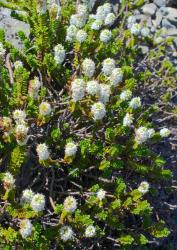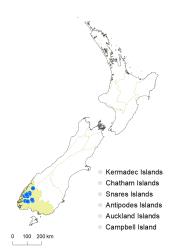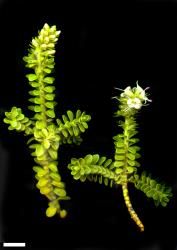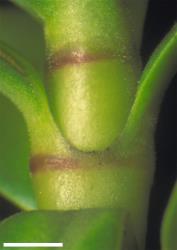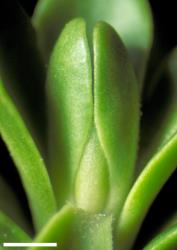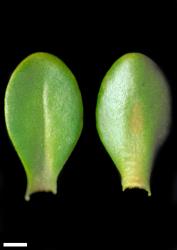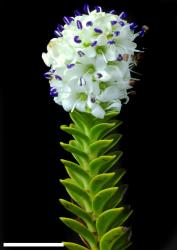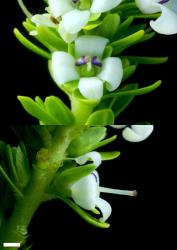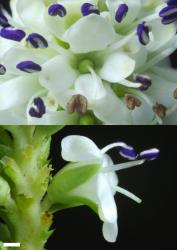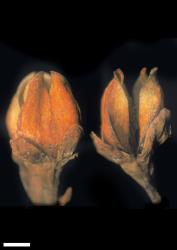- ≡ Hebe murrellii G.Simpson & J.S.Thomson, Trans. & Proc. Roy. Soc. New Zealand 73: 165 (1943)
- ≡ Hebe petriei var. murrellii (G.Simpson & J.S.Thomson) L.B.Moore in Allan, Fl. New Zealand 1, 938 (1961)
- ≡ Leonohebe petriei var. murrellii (G.Simpson & J.S.Thomson) Heads, Bot. Soc. Otago Newsl. 5: 6 (1987)
Low sub-shrub to 0.2 m tall. Stems decumbent to erect, glabrous or sometimes puberulent; hairs bifarious. Leaf bud distinct, its outer leaves fully grown, diverging. Leaves opposite-decussate to sub-distichous, shortly connate in pairs and encircling stem, erecto-patent to spreading; lamina sub-coriaceous, elliptic to obovate, 3.5–9.0 mm long, 2–5 mm wide, somewhat glossy yellowish-green above and beneath; midrib evident; surfaces with sparse eglandular hairs along midrib above and beneath; margin minutely ciliolate or glabrous, entire; apex broadly rounded to slightly retuse; base cuneate; petiole 1–2 mm long. Inflorescence a terminal raceme, 7–35 mm long; flowers crowded, 12–20, female or bisexual on separate plants, ⚥ > ♀; bracts alternate or rarely the lowest opposite, ovate to elliptic, > pedicels; pedicels erect to erecto-patent, 0.5–2.0 mm long, glandular-, eglandular-, or mixed puberulent. Calyx lobes 4, sub-acute to obtuse, 2.5–4.0 mm long, unequal, minutely mixed glandular- and eglandular-ciliolate. Corolla 5–7 mm diameter; tube white, 1.5–2.0 mm long, < calyx, glabrous; lobes 4, white, recurved, sub-equal, elliptic to obovate or orbicular, 2.5–5.0 mm long, obtuse to rounded; nectar guides absent. Stamen filaments white, 1–2 mm long; anthers purple. Style glabrous, 3–6 mm long. Capsules latiseptate, acute or sub-acute, glabrous, 3–5 mm long, 2–3 mm at widest point. Seeds discoid to ellipsoid; plano-convex, smooth, straw-yellow or pale brown, 0.9–1.1 mm long.
Veronica murrellii and V. petriei plants are similar and the species’ distributions overlap on the Takitimu Ranges, where they grow together between Tower Peak and Excelsior Peak (Garnock-Jones & Clarkson 1994). They both differ from other members of “Connatae” by their simple racemose inflorescences and alternate flowers and bracts (rarely the lowest flowers opposite). Both have sweet-scented flowers (other “Connatae” are stale-scented).
V. petriei plants can be distinguished from V. murrellii plants by their lax habit, stems barely pubescent and only at the leaf bases, darker green leaves that are more distinctly connate, longer, narrower calyx lobes, a long and narrow corolla tube, narrow and sub-erect to spreading corolla lobes, and magenta anthers presented at the corolla throat.
V. notialis plants have a similar habit to plants of V. murrellii and V. petriei , but differ in their rigid, highly glossy leaves, which usually have a densely hairy margin of branched and tangled hairs, lateral two- to four-flowered inflorescences, broader corolla lobes, and angustiseptate truncate to didymous capsules.
| murrellii | petriei |
Stem | glabrous or broadly bifariously puberulent | glabrous or puberulent at connate leaf bases |
Leaf bases | barely connate for 0.2–0.5 mm | connate for c. 0.5 mm |
Floral bracts | 3.5–5 × 1.7–2 mm, ovate to elliptic, usually all subtending flowers | 5–7 × 1–1.5 mm, linear to lanceolate, usually numerous sterile ones at base of inflorescence |
Calyx lobes | 4; 2.5–4 mm long, linear, lanceolate or narrowly elliptic, subacute to obtuse | 4–5, 3.5–6 mm long, linear to narrowly ovate, acute to acuminate |
Corolla tube | 1.5–2 mm long, funnelform | 3–6 mm long, cylindric |
Corolla lobes | elliptic to orbicular | linear to narrowly elliptic, posterior sometimes suborbicular |
Anthers | exserted, purple | presented at corolla throat, magenta |
South Island: Fiordland (on and east of the main divide from Earl Mountains to Mt Burns), Southland (Takitimu Mountains).
Alpine rock outcrops, boulder fields, talus, and scree. Recorded elevations range from 1100 to 1500 m.
Flowers: December–March; fruits: January–April.
2n = 42 (see Bayly & Kellow 2006, as Hebe murrellii).
Veronica murrellii is classified in V. subg. Pseudoveronica sect. Hebe and the informal group “Connatae” (Albach & Meudt 2010; Bayly & Kellow 2006). The connate leaf bases that are characteristic of the“Connatae” are only barely so in V. murrellii.
V. murrellii is an early-diverging single lineage in the hebe clade of New Zealand Veronica, according to analysis of ITS sequence data by E.M. Low. The similar V. petriei is a separate early lineage in the same part of the tree.



